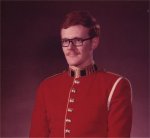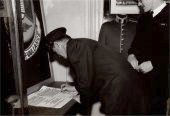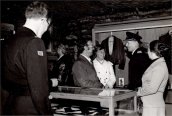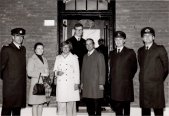PAUL JENKINS Graduate of College militaire royal de St Jean, Quebec 09540 (1968 - 1974) |
 |
BIOGRAPHY Paul Jenkins was born in England and, as the son of a naval officer, went to school in three Canadian provinces and England. He considers himself a Nova Scotian by adoption and marriage, but moved to Victoria in 2002 to be nearer to his family. His wife Jean is a retired English as a Second Language teacher. He has two daughters, both of whom have recently completed post-graduate studies. Paul served in the Canadian Forces for 31 years, retiring in 1999 as naval Captain. During his military career, he was employed as a Security Branch officer in postings throughout Canada and in Germany and served on United Nations duty in Cyprus. He has a varied background in law enforcement, security, operations, counter-intelligence, training, change management and program evaluation. He has commanded two military units, one an operational field unit (2 MP Platoon Petawawa) and the other a national level counter-intelligence unit (the Special Investigations Unit). He is a graduate of College militaire royal de Saint-Jean, Quebec, the Land Forces Staff College in Kingston, the Canadian Forces College in Toronto and the Canadian Police College in Ottawa. When he retired from the Canadian Forces, Paul completed a two year furniture making course at Algonquin College in Ottawa. Since moving to Victoria, Paul has become involved in a number of activities, including volunteering with the Sail and Life Training Society (SALTS) where he has put his wood working skills to good use, singing with the Open Door street choir, serving as Vice Chair of the Our Place Society (homeless housing and drop-in centre) and participating in a number of outreach activities through First Metropolitan United Church. Paul has also been a member of the Canadian Red Cross for 13 years since his retirement. He has served in both staff and volunteer positions, including President of the BC Coastal Region Council. He is currently Project Manager of the National Disaster Response Plan, working for the National Office. |
![]()
The Early Days of the Fort Saint-Jean Museum 1964 – 1970 Dr Ruddy has covered the original establishment of the museum in 1964/65. He received quite a bit of support from the college registrar, Monsieur D. Dion and other interested parties. He also notes the gathering of artefacts from various sources and moving them into the old guard house, with the help of officer cadets. When I arrived at Collège militaire royal (CMR) as a Prepatory OCdt in 1968, I had no background in museums and no particular interest in what was then called the CMR Museum. I was probably first introduced to it through Dr Ruddy, and gradually gained an interest, especially as it gave me a break from the very regimented life of the college in those days. As I recall, we spent our time organizing the collection and also doing some impromptu digs for artefacts, especially when construction crews dug up any of the grounds. We actually found an amazing collection of items, including coins, pottery, buttons, some metal pieces, etc. On one of our digs, we found a modern coin that somebody had buried there the day before! The museum was on the agenda of the Comité d’Ambiance, and I believe it had various plans for the museum, but not much had actually transpired. Lack of worker bees appeared to be one of the issues. 1970 – 1974 My involvement with CMR and the museum was suddenly interrupted in January 1970 as a result of a broken wrist and subsequent surgery. I had to go on Leave Without Pay until September of that year, but this proved to be a turning point. Dr Ruddy suggested that I look up a friend of his, Niels Jannasch, Curator of the Maritime Museum in Halifax, where I was to spend my time until I returned to CMR. This was a great stroke of luck. Niels took me on as a volunteer and then as a paid Museum Assistant at the new museum in Halifax. I learned a tremendous amount about museum science and almost remained there as a full-time employee, rather than returning to CMR. But saner minds prevailed, and I returned in September 1970, with lots of ideas and motivation to turn the CMR Museum into a real museum. One of my first initiatives was to write a full report to the Comité d’Ambiance, recommending a number of things:
I signed this report as Assistant Curator. During the 1970 to 1974 period, Dr Ruddy was the Director of the museum, but he was not heavily involved and he left most of the day-to-day work to a group of OCdts, lead by me. He was also absent for at least a year on sabbatical. This gave me a great opportunity to develop my skills which served me very well in years to come. The rest of the 1970/71 academic year was spent doing research on the history of Fort Saint-Jean, planning exhibits and constructing exhibits with the assistance of the Museum Club that was established. We had a slow start. As a result of yet another broken bone, I spent the summer at CMR and continued working on the museum. Things started to pick up in 1971/72 as I became involved with the Organization of Military Museums of Canada and completed some Canadian Museum Association credit seminars at the War Museum in Ottawa. That year the Museum Club became more active, and we carried on with display construction, opened the museum to the public on a number of occasions and arranged some loans from the War Museum. The 1972/73 academic year saw us apply for and get official status as a military museum under the CF Museum Committee and I was able to get funding under the related CFAO. We also submitted a Winter Works project for improvements to the building. This project was overly ambitious, and not much of the work was actually done. Cadet involvement in this year and 1973/74 increased considerably, with over 1700 man-hours being volunteered. A group of five or six contributed a lot of their free time and weekends preparing the museum for the eventual official opening. Three senior cadets did a fourth year communications project that among other things, recommended changing the name of the CMR Museum to its current name. My final year at CMR (1973/74) was a frantic one. In my last term, I turned the role of Curator over to OCdt Chris Cottle who was one year behind me and had been active in the museum for several years. I was appointed Cadet Wing Administration Officer, but still remained involved in organizing the official opening on 6 May 1974. In March 74, I wrote an extensive report to the college staff, outlining many of the things that were required to see the museum move ahead successfully:
Most of these recommendations were approved, and we saw the museum open successfully in May. The following month, I graduated and was posted to CFB Halifax to begin my career as a Security Branch officer. My museum experience followed me however. I served on the Marcom Museum Committee in 1974/75 and when I was posted to CFB Shearwater in 1978, I eventually became the Curator of the Shearwater Aviation Museum, which opened to the public in June 1981. I remain a fan of museums to this day, although my direct involvement has been far less in recent years. I would like to underscore the effort that the OCdts of CMR put into this project. The museum would not have gotten off the ground without their organizing abilities and hard work. The college staff provided the support we needed, but we did the work! |
![]()
Opening of the Museum
May 1974
![]()





